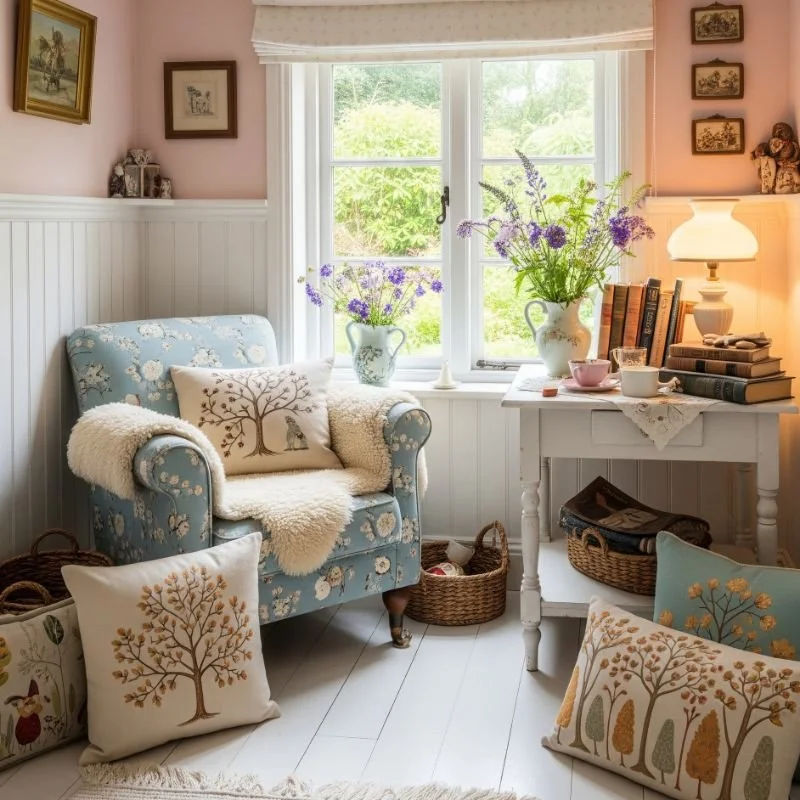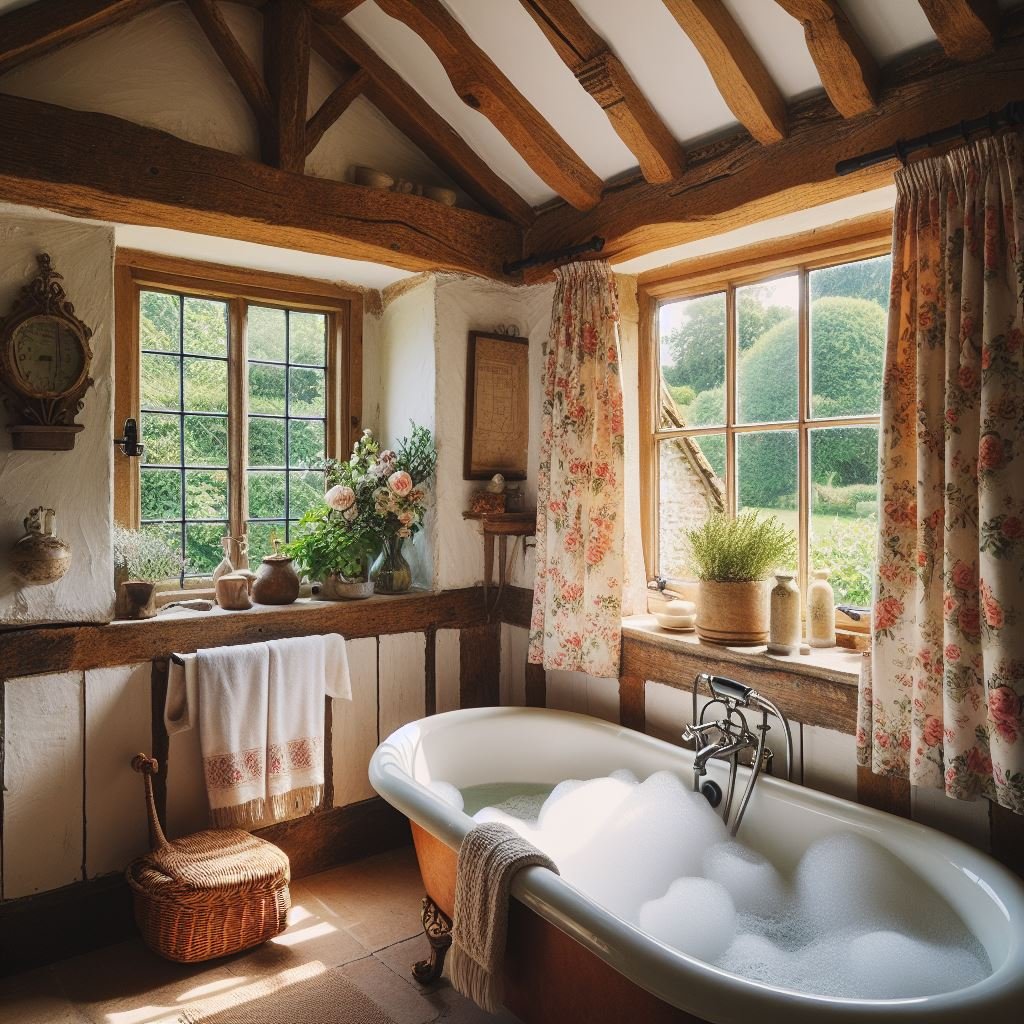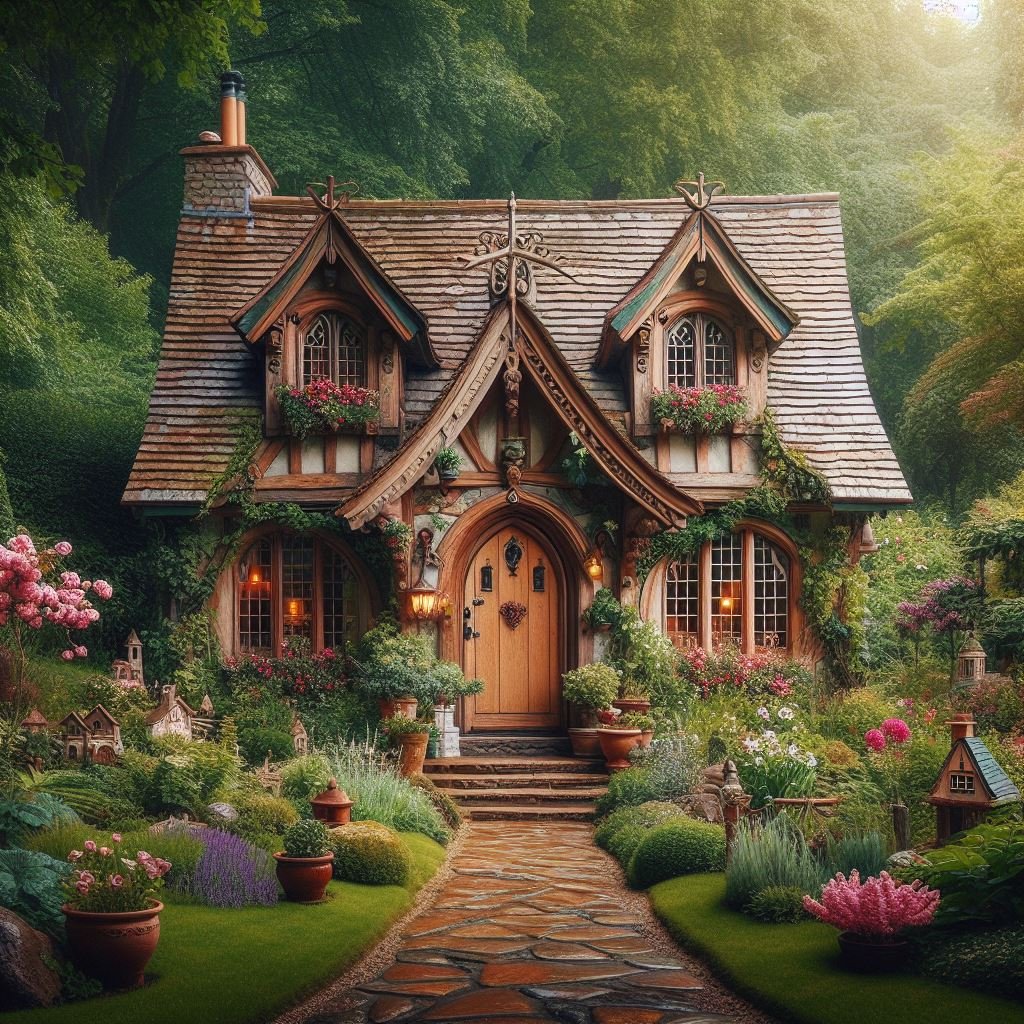15 Cute Cottage Room Ideas for Cozy, Stylish Charm
Transform any space with these 15 cottage room ideas that blend vintage charm, natural elements, and cozy textiles for authentic, lived-in elegance.
Have you ever walked into a room and felt immediately embraced by its warmth, as if the space itself were extending a gentle invitation to kick off your shoes and stay awhile? That's the magic of cottage style—a design approach that feels less like a carefully curated aesthetic and more like a heartfelt embrace. Unlike the austere perfection of minimalism or the calculated opulence of luxury design, cottage interiors speak to something more fundamental in our human experience: our deep-seated longing for comfort, simplicity, and connection to both past and present. They whisper rather than shout, suggesting stories of afternoon naps in sun-dappled corners, conversations that stretch long into evening hours, and the simple pleasure of being surrounded by objects chosen for love rather than status. What makes cottage style particularly captivating in our modern era is its gentle rebellion against the disposable nature of contemporary living—it celebrates the patina of well-loved furniture, the character of architectural imperfections, and the soulful beauty of handcrafted elements. Whether you inhabit an actual centuries-old cottage with stone walls and exposed beams, or a standard-issue apartment with builder-grade finishes, these fifteen ideas will help you capture that ineffable cottage magic—creating rooms that feel like they've evolved naturally over time rather than materialized overnight from a catalog. Let's discover how to transform your spaces into storybook settings that balance whimsy with sophistication, nostalgia with relevance, and above all, create that coveted sense of cottage coziness that makes everyone feel instantly at home.
1. Layered White Textiles for Ethereal Softness
Nothing captures cottage charm quite like an abundance of white textiles in varying textures and weights, creating depth without visual clutter. Imagine a bed dressed in layers of linens—crisp cotton sheets peek out beneath a softly rumpled linen duvet, topped with a chunky knit throw casually draped across one corner, while an assortment of pillows in different shapes creates an inviting landscape against the headboard. The magic lies in the subtle variations of white—from warm ivory to cool alabaster—that prevent the palette from feeling sterile. Throughout the room, continue this textural story with gauzy curtains that diffuse sunlight into a dreamy glow, a nubby rug underfoot that adds warmth, and perhaps a slipcover in washable cotton that embraces an armchair's curves. This approach creates a room that feels like sleeping inside a cloud while remaining practical enough for everyday living.
2. Exposed Wooden Beams and Architectural Details
The skeleton of your space tells the most authentic cottage story, revealing history through exposed wooden beams that map the ceiling like ancient tree branches stretching overhead. If you're fortunate enough to have original architectural elements, celebrate them by stripping away decades of paint to reveal the timber's natural character, complete with knots, grain patterns, and even the occasional imperfection that speaks to its age. Don't despair if your home lacks these features—strategic additions of reclaimed wood beams can transform even the most characterless drywall ceiling into a statement of rustic elegance. The contrast between rough-hewn wood and smooth wall surfaces creates visual tension that draws the eye upward, making rooms feel more spacious while simultaneously more intimate. Consider extending this principle to doorways with simple wooden lintels, window frames with thicker wooden surrounds, or even decorative brackets that suggest structural purpose while adding dimensional interest to plain walls.
3. Vintage Floral Patterns with Modern Restraint
Floral patterns and cottage style have danced together for centuries, but today's interpretation requires thoughtful restraint to avoid the overly precious or grandmother's-attic effect. The contemporary approach introduces vintage floral prints selectively, perhaps through a statement armchair upholstered in faded chintz, or pillow covers featuring botanical prints in colors that have softened with imagined age. The key lies in balancing these patterns with plenty of breathing room—pair that floral chair with solid-colored companions, or let those botanical pillows rest against a neutral sofa. Consider scale variation too—mixing small-scale, delicate florals with bolder, more graphic interpretations creates dynamic tension. For modern edge, try unexpected color combinations like traditional floral patterns rendered in moody indigos or mossy greens rather than predictable pastels. This approach honors tradition while feeling fresh, like heritage seeds planted in contemporary soil, blooming into something both familiar and surprisingly new.
4. Open Shelving with Curated Collections
Cottage rooms tell personal stories through thoughtfully arranged collections that balance practicality with beauty on open shelving. Unlike stark minimalist displays, cottage shelving embraces a certain casual abundance—stacks of mismatched plates in complementary colors, ironstone pitchers gathered over time, or vintage teacups that await afternoon visitors. The secret lies in curation that appears effortless yet actually follows loose organizing principles: varying heights create rhythm, while grouping similar items (all white ceramics, or books arranged by size rather than alphabetically) prevents visual chaos. Leave negative space between groupings to allow each collection to breathe rather than crowding every available inch. Incorporate practical items alongside purely decorative ones—the wooden spoons and copper measuring cups you actually use gain beauty through their evidence of loving use. The resulting displays should feel like visual poems—collections of objects that speak to one another across the shelf, revealing personality through their very selection and arrangement.
5. Window Seats and Reading Nooks
What captures cottage charm more perfectly than a window seat nestled into a deep sill, beckoning you to curl up with a book while rain taps gently against the glass? These architectural embraces transform transitional spaces into destinations, converting what might be wasted square footage into the most coveted spot in the house. If your home lacks built-in window seats, create similar nooks by positioning a small loveseat or upholstered bench beneath a window, then anchoring it with wall-mounted shelving or a side table that brings functionality to the fantasy. Layer in elements that enhance comfort—plump cushions in washable fabrics, a basket of throw blankets within arm's reach, perhaps a small table just large enough to hold a steaming mug. The intimacy of these spaces makes them natural conversation pits too, encouraging the kind of face-to-face connection that larger seating arrangements sometimes discourage. These nooks become the physical embodiment of cottage living's greatest gift—permission to slow down and savor life's quieter pleasures.
6. Mixed Vintage Furniture with Contemporary Touches
The most soulful cottage rooms reject matching furniture sets in favor of pieces that appear to have been collected gradually across generations, each bringing its own history to the conversation. A weathered farmhouse table might share space with mid-century dining chairs, while a contemporary sofa draped in vintage quilts anchors a seating area that includes your grandmother's lovingly restored rocking chair. This deliberate mix creates rooms that feel evolved rather than decorated, with an authenticity that can't be purchased in a single shopping trip. The key to preventing visual chaos lies in finding common elements that create cohesion—perhaps a consistent wood tone that repeats across different pieces, or a color story that subtly connects disparate styles. Contemporary elements prevent the look from feeling like a time capsule; a sleek floor lamp alongside an antique desk, or modern artwork above a vintage console creates tension between time periods that feels intentional rather than accidental. This approach honors the cottage tradition of practicality—using what's beautiful, meaningful, and available rather than adhering to rigid design rules.
7. Botanical Elements and Garden-Inspired Accents
True cottage style blurs the boundary between indoors and garden, bringing nature's rhythms and textures inside through thoughtfully chosen botanical elements. Unlike formal floral arrangements, cottage botanicals embrace a just-gathered aesthetic—wildflowers stuffed into a simple pitcher, branches of flowering quince forced to bloom in late winter, or herbs drying in bundles from exposed beams. Extend this garden inspiration through botanical prints framed simply in weathered wood, throw pillows embroidered with native plant motifs, or vintage seed packets displayed as ephemeral art. The cottage approach to plants feels democratic rather than precious—terracotta pots with patina sit alongside foraged mushroom specimens under glass cloches, celebrating nature's diversity rather than curating it too strictly. Even artificial elements can participate when chosen carefully—high-quality faux stems mixed with real foliage extend seasonal beauty, particularly in rooms with challenging light conditions. This continuous connection to growing things anchors cottage rooms in the natural world, reminding us of seasonal changes even as they create timeless appeal.
8. Painted Wooden Floors with Artful Distressing
Nothing signals cottage authenticity quite like painted wooden floors that tell stories of generations walking the same paths. These practical surfaces—historically painted because quality floor coverings were expensive luxuries—now serve as character-rich foundations for contemporary cottage rooms. Consider chalky whites that brighten spaces while showing the gentle wear of daily life, soft grays that recede and allow other elements to shine, or even bolder choices like maritime blue or sage green for unexpected personality. The magic lies in the finish—rather than factory-perfect uniformity, cottage floors celebrate subtle imperfection. New floors can be distressed strategically to suggest history, while truly old floors need only selective restoration that preserves their patina of age. Layer these painted surfaces with natural fiber rugs in seagrass or jute that add textural warmth while standing up to real-life traffic patterns. The resulting foundation feels both practical and poetic—durable enough for muddy boots and pet paws, yet beautiful enough to anchor your most cherished furnishings.
9. Soft, Natural Lighting Solutions
Cottage rooms reject harsh overhead lighting in favor of a layered approach that mimics the gentle illumination of natural daylight filtering through trees. Begin by maximizing window light—choose simple treatments that frame views rather than obscuring them, like café curtains that provide privacy while allowing sunshine to pour through upper panes. Supplement natural light with table lamps featuring textural bases (weathered wood, textured ceramics, or vintage glass) topped with linen or parchment shades that diffuse light into a warm glow. Wall sconces with articulated arms bring adjustable task lighting to reading nooks without requiring permanent wiring. Consider the humbler light sources too—pillar candles grouped on a tray, fairy lights twisted through a glass cloche, or even a simple oil lamp that creates flickering intimacy during power outages. The resulting lighting design should feel like conversation between sources rather than a single declaration—each light participating in the creation of an atmosphere that shifts naturally from morning brightness to evening coziness.
10. Unexpected Color Pops in Neutral Frameworks
While cottage style often evokes images of all-white interiors, authentic cottage rooms traditionally incorporated surprising moments of vibrant color against neutral backgrounds—think of the traditional red Aga stove warming an otherwise white kitchen, or cobalt blue bottles lining a sun-bleached windowsill. Create your own colorful moments by introducing concentrated bursts of pigment that draw the eye and energize spaces without overwhelming them. Perhaps a single armchair upholstered in saffron yellow velvet becomes the focal point of a seating arrangement, or kitchen shelves painted duck-egg blue peek through white ironstone collections. These strategic color placements function like punctuation in a well-crafted sentence—providing emphasis and rhythm without changing the overall tone. The most successful cottage color stories feel slightly faded and softened, as though gently aged by sunlight and use rather than freshly applied from the paint can. This approach honors the cottage tradition of using color joyfully yet practically, creating rooms that feel both cheerful and restful simultaneously.
11. Textural Contrast Through Mixed Materials
The most touchable cottage rooms incorporate multiple textures that create sensory richness without visual clutter. Imagine the pleasing contrast between a smooth soapstone countertop and rough-hewn open shelving above, or how a sleek enamel farmhouse sink feels more special nestled into a wooden counter with visible grain. This textural conversation should continue throughout your space—glossy ceramic lamps atop matte wooden tables, nubby linen draperies against smooth plaster walls, or shiny copper cookware hanging from matte iron hooks. The key lies in balance—each texture complementing rather than competing with its neighbors, creating rooms that reveal their full character through touch as much as sight. This multi-sensory approach explains why cottage rooms feel instantly comfortable; they engage our full physical experience rather than presenting themselves as visual tableaux meant only to be admired from a distance. When selecting materials, consider how they age—natural materials like wood, stone, and natural textiles generally develop richer patinas over time, contributing to that essential cottage quality of graceful weathering.
12. Repurposed Antiques for Practical Storage
Cottage style elevates storage beyond mere functionality by repurposing unexpected antiques that bring history and character to everyday organization. An old baker's rack finds new purpose displaying a collection of white dinnerware in the dining room. A weathered stepladder becomes tiered shelving for plants by a sunny window. Vintage suitcases stack into a bedside table while concealing out-of-season clothing inside. The cottage approach favors these characterful solutions over mass-produced storage systems, understanding that visible storage contributes to the room's personality rather than detracting from it. Look for pieces with inherent architectural interest—library card catalogs with their many small drawers, apothecary cabinets with glass-fronted compartments, or general store display cases with sliding doors. Beyond their practical function, these repurposed pieces serve as conversation starters and storytellers, often becoming the most distinctive elements in your rooms. The resulting storage solutions feel collected rather than calculated, evolving naturally as your needs change rather than rigidly defining your organizational system.
13. Handcrafted Textiles and Artisanal Elements
The soul of cottage style lives in the visible human touch—elements that could never have emerged from a factory assembly line, bearing the subtle irregularities that signal human creation. Incorporate handwoven blankets with slightly uneven edges, hand-blocked textiles where you can discern the printmaker's pressure variations, or hand-thrown pottery where finger ridges remain visible beneath the glaze. These imperfections aren't flaws but signatures, evidence of the maker's presence that industrial processes deliberately eliminate. Layer these artisanal elements throughout your rooms—perhaps a quilt passed through generations draped across a contemporary sofa, embroidered pillowcases that took months to complete, or baskets woven by local craftspeople. The beauty of these items transcends their practical function, creating connections across time and geography to other human hands and hearts. In our increasingly digital world, these tactile, imperfect elements ground us in physical reality while honoring traditions of craftsmanship that define cottage living at its most authentic core.
14. Intimate Dining Spaces with Rustic Elegance
Cottage dining embraces informality without sacrificing beauty, creating intimate gathering spaces that encourage lingering conversations over simple meals. Center your dining area around a table with character—perhaps a farmhouse table with visible knife marks and water rings that tell stories of gatherings past, or a round pedestal table whose democratic shape encourages eye contact and connection. Surround it with chairs that prioritize comfort over matching perfection—maybe Windsor chairs in various finishes, painted farmhouse chairs with woven rush seats, or even a dining bench along one side that accommodates unexpected extra guests. Above, a simple chandelier scaled appropriately to the table (smaller and lower than you might expect) creates an intimate pool of light that draws people together. Set the table with an approach that balances practicality with beauty—linen napkins that improve with washing, mismatched plates united by color family, and glassware that's sturdy enough for daily use but special enough for celebrations. This creates dining spaces that feel prepared for both Tuesday night family suppers and special holiday gatherings without major transformations.
15. Character-Adding Architectural Salvage
The most distinctive cottage rooms incorporate architectural elements salvaged from older structures, creating instant character and historical connection that new construction often lacks. Consider how a weathered wooden door repurposed as a headboard brings texture and narrative to a bedroom, or how antique porch balusters installed as kitchen island supports add unexpected architectural detail. Look beyond the obvious—old window frames without glass become wall art or photo displays, Victorian heat grates transform into decorative wall panels, and salvaged mantels create architectural framing even without fireplaces. The patina on these elements—layers of old paint, worn edges from decades of hands, or subtle warping from age—cannot be convincingly replicated and brings authenticity that grounds newer spaces. When incorporating salvage, resist the urge to over-restore; gentle cleaning that preserves the history is usually preferable to stripping and refinishing that erases evidence of an object's journey. These salvaged pieces serve as anchors in your design, connecting your contemporary life to the craftsmanship and materials of earlier eras.
Conclusion
Creating a cottage-inspired space isn't about following rigid design rules or achieving perfect historical accuracy—it's about cultivating rooms that embrace you with comfort while telling your unique story. The most successful cottage interiors balance pragmatism with poetry, mixing old and new, rough and smooth, humble and special in ways that feel authentic rather than contrived. As you incorporate these fifteen ideas into your own spaces, remember that true cottage style evolves gradually, welcoming the natural accumulation of beloved objects and the subtle marks of everyday living. Your rooms should feel like they couldn't possibly belong to anyone else—personal sanctuaries that honor tradition while remaining thoroughly livable for today's realities.
Read next: 15 Cozy Cottage Bedroom Ideas for Charming Comfort
Frequently Asked Questions
1. How can I create cottage charm in a modern apartment with few architectural details?
Focus on textural layering, vintage furniture pieces, and soft lighting to compensate for architectural simplicity.
2. What's the most important element to capture authentic cottage style?
Embrace imperfection—slightly rumpled linens, gently worn furniture, and handmade elements create genuine cottage character.
3. How do I prevent my cottage-inspired room from looking cluttered?
Maintain plenty of negative space between collections, use consistent color palettes, and edit possessions regularly.
4. Can cottage style work with existing modern furniture?
Yes! Soften contemporary pieces with vintage textiles, handcrafted accessories, and natural elements for balanced contrast.
5. What's the most budget-friendly way to begin a cottage transformation?
Start with paint in soft, natural tones, add textural textiles, and incorporate foraged botanical elements.

























